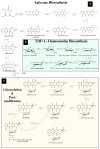The Daunomycin: Biosynthesis, Actions, and the Search for New Solutions to Enhance Production
- PMID: 39770841
- PMCID: PMC11676270
- DOI: 10.3390/microorganisms12122639
The Daunomycin: Biosynthesis, Actions, and the Search for New Solutions to Enhance Production
Abstract
Daunorubicin (DNR) is an anthracycline antibiotic originating from soil-dwelling actinobacteria extensively used to treat malignant tumors. Over the decades, extensive attempts were made to enhance the production of anthracyclines by introducing genetic modifications and mutations in combination with media optimization, but the target production levels remain comparatively low. Developing an appropriate culture medium to maximize the yield of DNR and preventing autotoxicity for the producing organism remains a challenge. Our prospective review sheds light on a method involving perturbation that enhances the precursors to regulate the type II PKS pathway, enhancing cells' capacity to increase secondary metabolite production. The suggested method also entails the preparation of culture media for the cultivation of Streptomyces sp. and enhanced yield of DNR, as well as making it inactive with iron or its reduced forms following efflux from the producer. The iron or iron-DNR complex is encapsulated by oleic acid or lipid micelle layers in the culture media, finally resulting in the generated inactive DNR and the DNR-iron-oil complex. This idea has the potential to protect the producer organism from autotoxicity and prevent the inhibition of metabolite production. The approach of substituting sugar with oil in culture media has a dual role wherein it promotes Streptomyces growth by utilizing lipids as an energy source and encapsulating the generated DNR-iron complex in the medium. In this review, we discussed aspects like anthracycline producers, biosynthesis pathways, and gene regulation; side effects of DNR; mechanisms for autotoxicity evasion; and culture media components for the enhancement of DNR production in Streptomyces sp. We anticipate that our work will help researchers working with secondary metabolites production and decipher a methodology that would enhance DNR yield and facilitate the extraction of the resulting DNR by lowering costs in large-scale fermentation.
Keywords: Streptomyces; anthracyclines; autotoxicity; daunomycin; efflux; enhancement; oil-based medium.
Conflict of interest statement
Authors Karel Beneš and Vladimir Matha were employed by the company VUAB Pharma A.S. The remaining authors declare that the research was conducted in the absence of any commercial or financial relationships that could be construed as a potential conflict of interest.
Figures


Similar articles
-
Autonomous Defense Based on Biogenic Nanoparticle Formation in Daunomycin-Producing Streptomyces.Microorganisms. 2025 Jan 8;13(1):107. doi: 10.3390/microorganisms13010107. Microorganisms. 2025. PMID: 39858875 Free PMC article.
-
Improvement of antibiotic productivity by knock-out of dauW in Streptomyces coeruleobidus.Microbiol Res. 2011 Oct 20;166(7):539-47. doi: 10.1016/j.micres.2010.10.006. Epub 2011 Jan 15. Microbiol Res. 2011. PMID: 21242069
-
Overexpression of a pathway specific negative regulator enhances production of daunorubicin in bldA deficient Streptomyces peucetius ATCC 27952.Microbiol Res. 2016 Nov;192:96-102. doi: 10.1016/j.micres.2016.06.009. Epub 2016 Jun 22. Microbiol Res. 2016. PMID: 27664727
-
The Minderoo-Monaco Commission on Plastics and Human Health.Ann Glob Health. 2023 Mar 21;89(1):23. doi: 10.5334/aogh.4056. eCollection 2023. Ann Glob Health. 2023. PMID: 36969097 Free PMC article. Review.
-
Response surface methodology: A non-conventional statistical tool to maximize the throughput of Streptomyces species biomass and their bioactive metabolites.Crit Rev Microbiol. 2017 Sep;43(5):567-582. doi: 10.1080/1040841X.2016.1271308. Epub 2017 Jan 27. Crit Rev Microbiol. 2017. PMID: 28129718 Review.
Cited by
-
Characterization of natural therapeutic compounds producing novel bacterial strains isolated from Hyderabad, India.Sci Rep. 2025 Jul 16;15(1):25681. doi: 10.1038/s41598-025-11615-5. Sci Rep. 2025. PMID: 40664890 Free PMC article.
-
Autonomous Defense Based on Biogenic Nanoparticle Formation in Daunomycin-Producing Streptomyces.Microorganisms. 2025 Jan 8;13(1):107. doi: 10.3390/microorganisms13010107. Microorganisms. 2025. PMID: 39858875 Free PMC article.
-
Genome mining identifies a diversity of natural product biosynthetic capacity in human respiratory Corynebacterium strains.mSphere. 2025 Jun 25;10(6):e0025825. doi: 10.1128/msphere.00258-25. Epub 2025 May 21. mSphere. 2025. PMID: 40396729 Free PMC article.
References
Publication types
Grants and funding
LinkOut - more resources
Full Text Sources
Molecular Biology Databases
Miscellaneous

